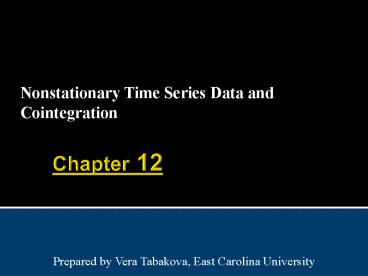Nonstationary Time Series Data and Cointegration - PowerPoint PPT Presentation
1 / 38
Title:
Nonstationary Time Series Data and Cointegration
Description:
12.3.1 Dickey-Fuller Test 1 (no constant and no trend) ... An important extension of the Dickey-Fuller test allows for the possibility that ... – PowerPoint PPT presentation
Number of Views:369
Avg rating:3.0/5.0
Title: Nonstationary Time Series Data and Cointegration
1
Chapter 12
- Nonstationary Time Series Data and Cointegration
Prepared by Vera Tabakova, East Carolina
University
2
Chapter 12 Nonstationary Time Series Data and
Cointegration
- 12.1 Stationary and Nonstationary Variables
- 12.2 Spurious Regressions
- 12.3 Unit Root Tests for Stationarity
- 12.4 Cointegration
- 12.5 Regression When There is No Cointegration
3
12.1 Stationary and Nonstationary Variables
- Figure 12.1(a) US economic time series
4
12.1 Stationary and Nonstationary Variables
- Figure 12.1(b) US economic time series
5
12.1 Stationary and Nonstationary Variables
6
12.1 Stationary and Nonstationary Variables
7
12.1.1 The First-Order Autoregressive Model
8
12.1.1 The First-Order Autoregressive Model
9
12.1.1 The First-Order Autoregressive Model
10
12.1.1 The First-Order Autoregressive Model
- Figure 12.2 (a) Time Series Models
11
12.1.1 The First-Order Autoregressive Model
- Figure 12.2 (b) Time Series Models
12
12.1.1 The First-Order Autoregressive Model
- Figure 12.2 (c) Time Series Models
13
12.1.2 Random Walk Models
14
12.1.2 Random Walk Models
15
12.1.2 Random Walk Models
16
12.1.2 Random Walk Models
17
12.1.2 Random Walk Models
18
12.2 Spurious Regressions
19
12.2 Spurious Regressions
- Figure 12.3 (a) Time Series of Two Random Walk
Variables
20
12.2 Spurious Regressions
- Figure 12.3 (b) Scatter Plot of Two Random Walk
Variables
21
12.3 Unit Root Test for Stationarity
- 12.3.1 Dickey-Fuller Test 1 (no constant and no
trend)
22
12.3 Unit Root Test for Stationarity
- 12.3.1 Dickey-Fuller Test 1 (no constant and no
trend)
23
12.3 Unit Root Test for Stationarity
- 12.3.2 Dickey-Fuller Test 2 (with constant but no
trend)
24
12.3 Unit Root Test for Stationarity
- 12.3.3 Dickey-Fuller Test 3 (with constant and
with trend)
25
12.3.4 The Dickey-Fuller Testing Procedure
- First step plot the time series of the original
observations on the variable. - If the series appears to be wandering or
fluctuating around a sample average of zero, use
test equation (12.5a). - If the series appears to be wandering or
fluctuating around a sample average which is
non-zero, use test equation (12.5b). - If the series appears to be wandering or
fluctuating around a linear trend, use test
equation (12.5c).
26
12.3.4 The Dickey-Fuller Testing Procedure
27
12.3.4 The Dickey-Fuller Testing Procedure
- An important extension of the Dickey-Fuller test
allows for the possibility that the error term is
autocorrelated. - The unit root tests based on (12.6) and its
variants (intercept excluded or trend included)
are referred to as augmented Dickey-Fuller tests.
28
12.3.5 The Dickey-Fuller Tests An Example
29
12.3.6 Order of Integration
30
12.4 Cointegration
31
12.4 Cointegration
32
12.4.1 An Example of a Cointegration Test
33
12.4.1 An Example of a Cointegration Test
- The null and alternative hypotheses in the test
for cointegration are
34
12.5 Regression When There Is No Cointegration
- 12.5.1 First Difference Stationary
- The variable yt is said to be a first difference
stationary series.
35
12.5.1 First Difference Stationary
36
12.5.2 Trend Stationary
- where
- and
37
12.5.2 Trend Stationary
- To summarize
- If variables are stationary, or I(1) and
cointegrated, we can estimate a regression
relationship between the levels of those
variables without fear of encountering a spurious
regression. - If the variables are I(1) and not cointegrated,
we need to estimate a relationship in first
differences, with or without the constant term. - If they are trend stationary, we can either
de-trend the series first and then perform
regression analysis with the stationary
(de-trended) variables or, alternatively,
estimate a regression relationship that includes
a trend variable. The latter alternative is
typically applied.
38
Keywords
- Augmented Dickey-Fuller test
- Autoregressive process
- Cointegration
- Dickey-Fuller tests
- Mean reversion
- Order of integration
- Random walk process
- Random walk with drift
- Spurious regressions
- Stationary and nonstationary
- Stochastic process
- Stochastic trend
- Tau statistic
- Trend and difference stationary
- Unit root tests































